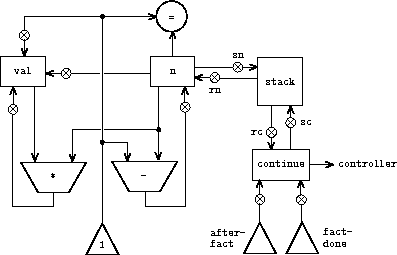Extend the assembler
The simulator can be used to help determine the data paths required for implementing a machine with a given controller. Extend the assembler to store the following information in the machine model:
- a list of all instructions, with duplicates removed, sorted by instruction type (
assign,goto, and so on); - a list (without duplicates) of the registers used to hold entry points (these are the registers referenced by
gotoinstructions); - a list (without duplicates) of the registers that are
saved orrestored; - for each register, a list (without duplicates) of the sources from which it is assigned (for example, the sources for register
valin the factorial machine of figure 5.11 are(const 1)and((op *) (reg n) (reg val))).
Extend the message-passing interface to the machine to provide access to this new information. To test your analyzer, define the Fibonacci machine from figure 5.12 and examine the lists you constructed.

(controller
(assign continue (label fact-done)) ; set up final return address
fact-loop
(test (op =) (reg n) (const 1))
(branch (label base-case))
;; Set up for the recursive call by saving n and continue.
;; Set up continue so that the computation will continue
;; at after-fact when the subroutine returns.
(save continue)
(save n)
(assign n (op -) (reg n) (const 1))
(assign continue (label after-fact))
(goto (label fact-loop))
after-fact
(restore n)
(restore continue)
(assign val (op *) (reg n) (reg val)) ; val now contains n(n - 1)!
(goto (reg continue)) ; return to caller
base-case
(assign val (const 1)) ; base case: 1! = 1
(goto (reg continue)) ; return to caller
fact-done)
Figure 5.11: A recursive factorial machine.
(controller
(assign continue (label fib-done))
fib-loop
(test (op <) (reg n) (const 2))
(branch (label immediate-answer))
;; set up to compute Fib(n - 1)
(save continue)
(assign continue (label afterfib-n-1))
(save n) ; save old value of n
(assign n (op -) (reg n) (const 1)); clobber n to n - 1
(goto (label fib-loop)) ; perform recursive call
afterfib-n-1 ; upon return, val contains Fib(n - 1)
(restore n)
(restore continue)
;; set up to compute Fib(n - 2)
(assign n (op -) (reg n) (const 2))
(save continue)
(assign continue (label afterfib-n-2))
(save val) ; save Fib(n - 1)
(goto (label fib-loop))
afterfib-n-2 ; upon return, val contains Fib(n - 2)
(assign n (reg val)) ; n now contains Fib(n - 2)
(restore val) ; val now contains Fib(n - 1)
(restore continue)
(assign val ; Fib(n - 1) + Fib(n - 2)
(op +) (reg val) (reg n))
(goto (reg continue)) ; return to caller, answer is in val
immediate-answer
(assign val (reg n)) ; base case: Fib(n) = n
(goto (reg continue))
fib-done)
Figure 5.12: Controller for a machine to compute Fibonacci numbers.